#anhima
Text

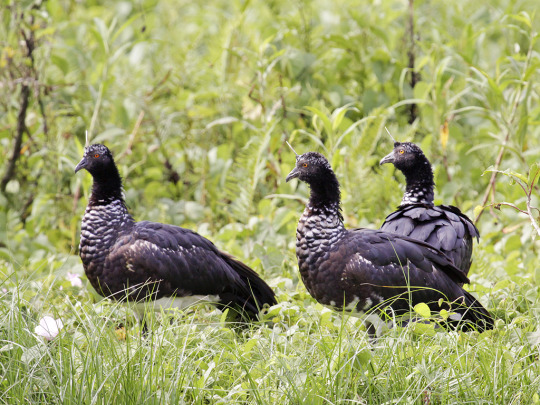
Horned Screamer (Anhima cornuta), family Anhimidae, order Anseriformes, found in central and northern South America
Mainly herbivorous waterfowl, in the same order as ducks and geese, but in a different family.
Screamers prefer to walk/wade through their habitats, instead of swimming. They can swim, but are not as proficient as ducks and geese.
photographs by Bill Bouton & Wagner Florentino
727 notes
·
View notes
Text
Horned Screamer (Anhima cornuta)

"The fact that the universe saw fit to let this thing exist"
"horn, prominent spurs on wings, "The most peculiar feature of the screamers is a skin filled with small bubbles of air about a quarter of an inch thick, which produce a crackling sound when pressed; the function of this layer of air bubbles is unknown.""
Hey these guys are ducks! No I'm not lying- they're ducks! They belong to the same order as ducks, geese, and swans! What the fuck!
While my surface level digging did not confirm this, my thought is that screamers represent a branch in anseriformes where the ducks had recently split from gamebirds in galliformes, but hadnt yet specialized to have their spatulate bills. I'm not a source to quote on this though, as the paleontological record is a bit hazy for screamers.
For some actual facts: their horn is not a modified feather or something adjacent, but is "a cornified structure loosely attached to the skull, which frequently breaks off at the tip." They eat water plants but only have partially webbed feet. They have wing spurs. Despite being 8lb (3.5kg) birds, they nest on floating vegetation. What the heck is going on with these guys??
Sources:
Image Source: eBird (Bradley Hacke)
109 notes
·
View notes
Text

Aniuma, Palamedea cornuta | Die Vogel (1913) | Alfred Edmund Brehm (1829-1884) | Biodiversity Heritage Library
#alfred edmund brehm#hornwehrvogel#anhima cornuta#anhimidae#biologie#ornithologie#vögel#illustration
4 notes
·
View notes
Text
BOTD: Horned Screamer

^image credit: Bill Bouton, Wikipedia
Horned Screamer (Anhima cornuta)
The Horned Screamer has a strange growth from its head that attaches loosely from the skull, which is unique among birds. Unlike other horned animals, which may use their horns for fighting, it is speculated that the Horned Screamer's 'horn' is merely decor, as it is fragile and often breaks at the tip, or even snap off once it gets too long - though it grows back.
#horned screamer#anhima cornuta#tropical birds#birding#cool birds#weird birds#weird animals#weird wildlife#weird and wonderful#birdwatching#birds#ornithology#bird of the day#birdoftheday#bird fact of the day#bird facts#bird fact#animal facts#bird#bird lovers#birdblr#bird tumblr
92 notes
·
View notes
Text
THIRD PLACE
Horned Screamer (Anhima cornuta)
They have a horn for no discernible reason that breaks off and grows back, have wing spurs for fighting, their skin CRACKLES when touched because they have air bubbles under there, and yes, they scream.
VERSUS
Hoatzin (Opisthocomus hoazin)
Their chicks have little fingers and claws on their wings for climbing. Also, they produce bacteria in their weird enlarged crops that are ONLY found in there. Their crops are so big that they don’t really fly. They smell like manure. They’re like if cows were birds if cows had claws and were super colorful.

40 notes
·
View notes
Text
Anachronornis anhimops Houde et al., 2023 (new genus and species)

(Skull [A–Q, S], rib fragment [R], and back vertebrae [T] of Anachronornis anhimops [scale bar = 1 cm], from Houde et al., 2023)
Meaning of name: Anachronornis = bird out of time [in Greek, referring to the late occurrence of a form similar to the expected appearance of the last common ancestor of modern waterfowl]; anhimops = Anhima [genus of the extant horned screamer] face [in Greek]
Age: Paleocene–Eocene (Thanetian–Ypresian), 55.8–56.22 million years ago
Where found: Willwood Formation, Wyoming, U.S.A.
How much is known: Partial skeleton of one individual, including a nearly complete skull and forelimbs.
Notes: Anachronornis was likely a close relative of modern waterfowl, which are divided into two major lineages: Anhimae (the screamers, which have slightly hooked, somewhat chicken-like bills) and Anseres (the duck- and goose-like waterfowl, which have broad, spatula-shaped bills). It exhibits a mixture of features characteristic of both of these groups, with the shape of its skull being especially screamer-like. It may therefore represent a form closely resembling the last common ancestor of all extant waterfowl, which would make it a very important discovery for understanding how modern ducks and geese evolved.
The type specimen of Anachronornis had been mentioned in previous scientific literature starting in the 1980s, but was left undescribed until now. Anachronornis may have foraged near water, like modern waterfowl, though it does not appear to have been particularly specialized for swimming or wading.
Reference: Houde, P., M. Dickson, and D. Camarena. 2023. Basal Anseriformes from the early Paleogene of North America and Europe. Diversity 15: 233. doi: 10.3390/d15020233
#Palaeoblr#Birblr#Dinosaurs#Birds#Anachronornis#Paleocene#Eocene#North America#Galloanserae#2023#Extinct
78 notes
·
View notes
Note
any thoughts on the horned screamer (Anhima cornuta) the bird with a spike on its head
this is some sort of primal beast i think . quite friendly looking though
1 note
·
View note
Photo

Iúna (Anhima cornuta)is a south american bird whose peculiar chant has inspired a berimbau rhythm with the same name, or so the legend says... #iúna #iúnamandingueira #berimbau #anhimacornuta #animalillustration #tierillustration (hier: Iúna) https://www.instagram.com/p/Ce1HmC8DFdg/?igshid=NGJjMDIxMWI=
2 notes
·
View notes
Photo
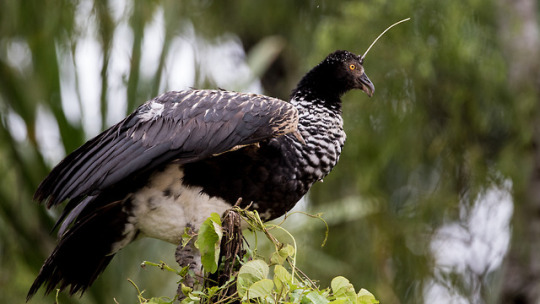
Anhima cornuta by Dirk van Mourik
2 notes
·
View notes
Text
Anhima cornuta
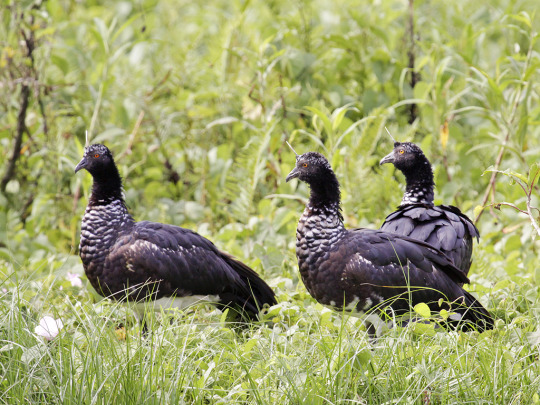
By Bill Bouton, CC BY-SA 2.0
PLEASE SUPPORT US ON PATREON. EACH and EVERY DONATION helps to keep this blog running! Any amount, even ONE DOLLAR is APPRECIATED! IF YOU ENJOY THIS CONTENT, please CONSIDER DONATING!
Name: Anhima cornuta
Status: Extant
First Described: 1760
Described By: Linnaeus
Classification: Dinosauria, Saurischia, Eusaurischia, Theropoda, Neotheropoda, Averostra, Tetanurae, Orionides, Avetheropoda, Coelurosauria, Tyrannoraptora, Maniraptoriformes, Maniraptora, Pennaraptora, Paraves, Eumaniraptora, Averaptora, Avialae, Euavialae, Avebrevicauda, Pygostylia, Ornithothoraces, Euornithes, Ornithuromorpha, Ornithurae, Neornithes, Neognathae, Galloanserae, Anseriformes, Anhimae, Anhimidae
The Horned Screamer is our first Screamer - a group of very weird birds that for a while were actually thought to be more closely related to chickens than to ducks! However, it turns out that they are close relatives of ducks and geese - potentially most closely related to the Magpie Goose, but that’s under some debate. They are weird compared to other Anseriformes for a few reasons - they lack specialized structures in the ribs, they don’t have penises, and their skin actually has bubbles of air in it, so when you press on the skin (don’t press on a Screamer’s skin) it makes a crackling sound. Large birds, they have spurs on their wings to fight over mates, and they live in open areas and marshes and feed mainly on water plants. Their young are precocial, and they get their name from their excessively loud screams they make when they see new things, or threatening things. The Horned Screamer specifically is huge, about 84 to 95 centimeters in size, with a chicken-like beak. They’re black with some white speckles on their feathers and they have a spiny on the head - hence their name, Horned Screamer. They are mainly known from Colombia, Venezuela, Brazil, Bolivia, Peru, Ecuador, Suriname, French Guiana, and Guyana, and is not threatened with extinction at this time. They lay about three eggs at a time on floating vegetation in shallow water, which is anchored to the shore.
Sources:
https://en.wikipedia.org/wiki/Screamer
https://en.wikipedia.org/wiki/Horned_screamer
#anhima#anhima cornuta#screamer#dinosaur#horned screamer#bird#duck#palaeoblr#birblr#paleontology#prehistory#prehistoric life#dinosaurs#biology#a dinosaur a day#a-dinosaur-a-day#dinosaur of the day#dinosaur-of-the-day#science#nature#factfile#Dìneasar#דינוזאור#डायनासोर#ديناصور#ডাইনোসর#risaeðla#ڈایناسور#deinosor#恐龍
40 notes
·
View notes
Photo
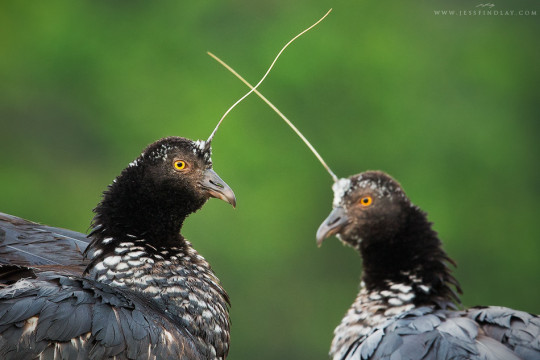
Horned screamer (Anhima cornuta) in the Peruvian Amazon
Jess Findlay
10K notes
·
View notes
Photo
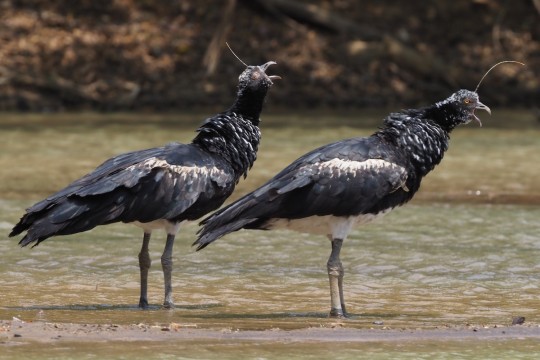
Horned Screamer (Anhima cornuta)
© Stephan Lorenz
78 notes
·
View notes
Photo

👉🏿Compagni creativi al lavoro! 🔝🚀 #leomartera #studiorecording #mylife #simoncia #anhima #tdfrdx #italy #producer (presso DPoT Recording Arts) https://www.instagram.com/p/Bwp3BrtlTlJ/?utm_source=ig_tumblr_share&igshid=9zyq6sg6q9rm
0 notes
Photo

HORNED SCREAMER
Anhima cornuta
©Joel Sartore
How did I not know this bird existed?
It’s a wetlands bird endemic to tropical South America. What makes it unique, is that it grows a bony cornified (keratinized) spike from it’s head, which frequently breaks and regrows, and it has a spur used for fighting, growing out of each wing.

©Pat ODonnell Rainforest Expeditions
The horned screamer is a massive 84–95 cm (33–37.5 in) long, 3.5 kg (7.7 lb) bird, with a small chicken-like bill. The upper parts, head, and breast are black, with white speckles on the crown, throat and wing coverts.
There is a long spiny structure projecting forward from the crown. This structure is unique among birds and is not derived from a feather but is a structure that is loosely attached to the skull and grows continuously. This gives this species its ‘horned’ name.
It has very long and lanky legs and three large toes in each. The belly and under wing coverts are white. It has two sharp spurs on its wings and feet which are only partially webbed.
The horned screamer's call, as its name suggests, is a very loud echoing sound. source
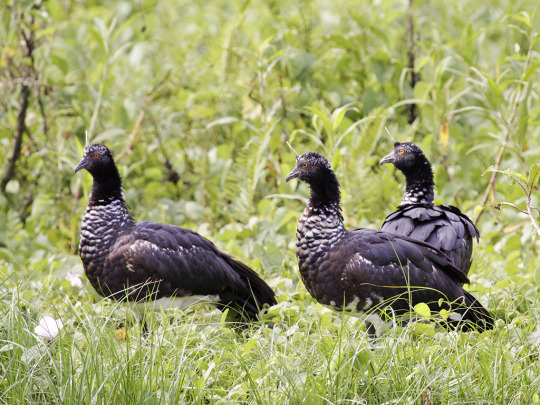
©Bill Bouton from San Luis Obispo, CA, USA Mostly they look like unicorn pheasants, more than the Anseriformes group they belong to which includes swans, geese and ducks.
#horned screamer#anhima cornuta#anseriformes#unicorn horn#cornified#keratin#northern half of South America#South America#lease concern#spur#fighting#loud call#screamer#bird#animal#anhimidae#waders#partially webbed feet#look like pheasant
49 notes
·
View notes
Text
BRACKET B
Long-Wattled Umbrellabird (Cephalopterus penduliger)
They were submitted MANY a time for having long wattles. When their wattles are inflated they look like weird pine cones!
VERSUS
Horned Screamer (Anhima cornuta)
They have a horn for no discernible reason that breaks off and grows back, have wing spurs for fighting, their skin CRACKLES when touched, and yes, they scream.
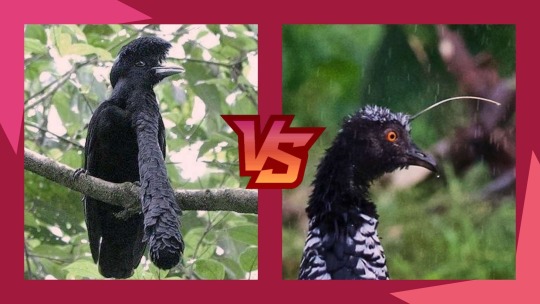
58 notes
·
View notes